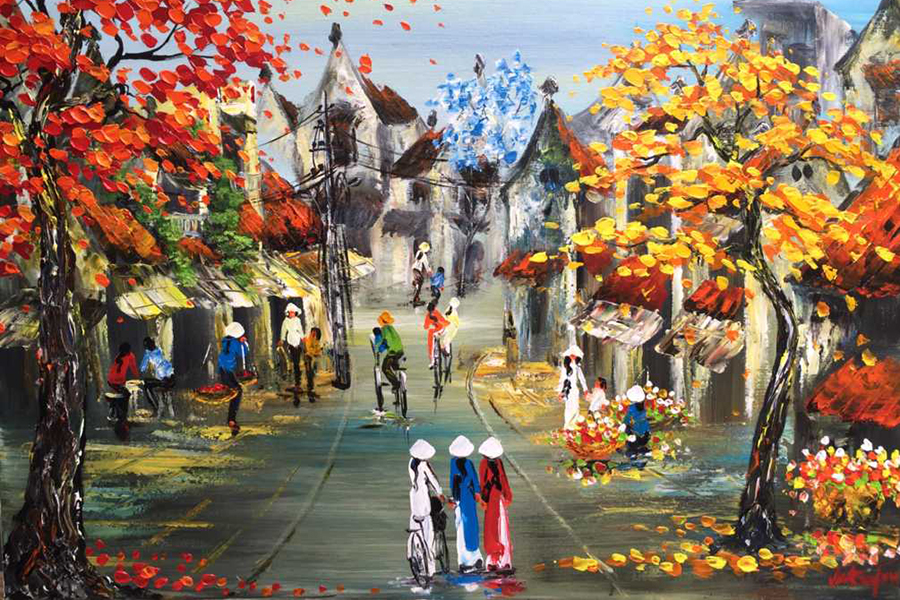Vietnam’s art scene is a vibrant fusion of tradition and innovation, and Vietnamese oil paintings play a significant role in this tapestry. For art enthusiasts visiting Vietnam, the world of oil paintings offers a captivating window into the country’s creative spirit. Let’s discuss Vietnamese Oil Painting, the diverse styles, themes, and narratives found in Vietnamese oil paintings, from timeless landscapes and rural life to thought-provoking social commentary.
What is the Vietnamese Oil Paintings?
Vietnamese oil paintings are a rich and diverse expression of artistic creativity within Vietnam. Artists in Vietnamese oil painting employ oil-based paints, usually mixed with linseed oil, to produce captivating artworks that encompass a wide range of subjects and styles. These paintings often serve as windows into Vietnamese culture, reflecting the nation’s history, traditions, and contemporary themes.
One of the defining features of Vietnamese oil paintings is the variety of subjects they explore. Artists draw inspiration from the landscapes, urban scenes, and rural life of Vietnam, as well as historical events, cultural practices, and the everyday experiences of its people. This diversity allows for a broad spectrum of artistic expression, ensuring that there is something for everyone to appreciate in Vietnamese oil painting.
The styles found in Vietnamese oil paintings are equally diverse. Some artists embrace traditional Vietnamese aesthetics, incorporating elements like lotus flowers or countryside landscapes. Others venture into modern and contemporary styles, experimenting with techniques like impasto or glazing. Often, these artists blend traditional and contemporary elements, producing unique and compelling artworks that bridge the past and present.
Cultural significance plays a significant role in Vietnamese oil paintings. Artists often incorporate traditional symbols, folklore, and iconic imagery that hold special meaning within Vietnamese society. This cultural resonance adds depth and significance to the artworks, making them not just visually appealing but also culturally meaningful.
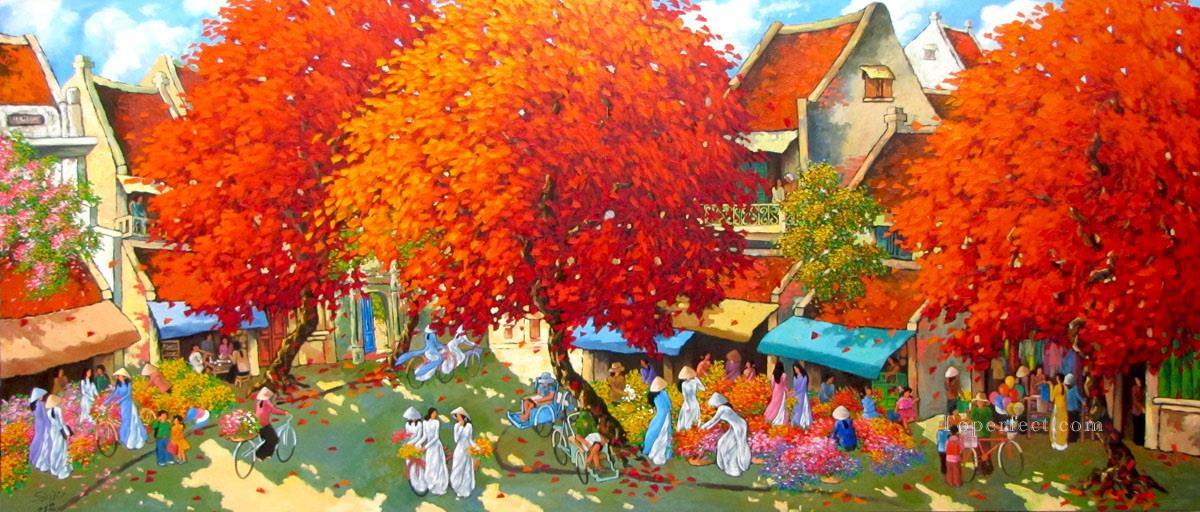
In addition to galleries and exhibitions, tourists and art enthusiasts can discover Vietnamese oil paintings in some Art tours. Here, local artists display and engage in discussions about the diverse styles, themes, and narratives found in Vietnamese oil paintings, from timeless landscapes and rural life to thought-provoking social commentary. Providing visitors with the opportunity to engage directly with creators and acquire unique pieces of art. The fusion of tradition and innovation within Vietnam’s art scene keeps the medium dynamic and reflective of the country’s ever-evolving culture and society.
The Special Materials Used in Vietnamese Oil Paintings
Vietnamese oil paintings, much like oil paintings worldwide, involve the use of specific materials that contribute to the distinctive characteristics of the art form. While the foundational materials are common, there are unique elements that add a distinct touch to Vietnamese oil paintings. Here are the special materials used in Vietnamese oil paintings:
Lotus Leaf Canvas
In Vietnamese oil painting, the canvas made from lotus leaves or inspired by lotus leaf texture is a special material. The lotus holds great cultural significance in Vietnam, and using lotus leaf texture in paintings symbolizes purity and enlightenment.
Natural Pigments from Vietnamese Soil
Artists often use pigments derived from Vietnamese soil, including earthy tones like ochre and terracotta. These pigments add a unique local color palette and reflect the natural landscapes of Vietnam in Vietnamese Oil Painting
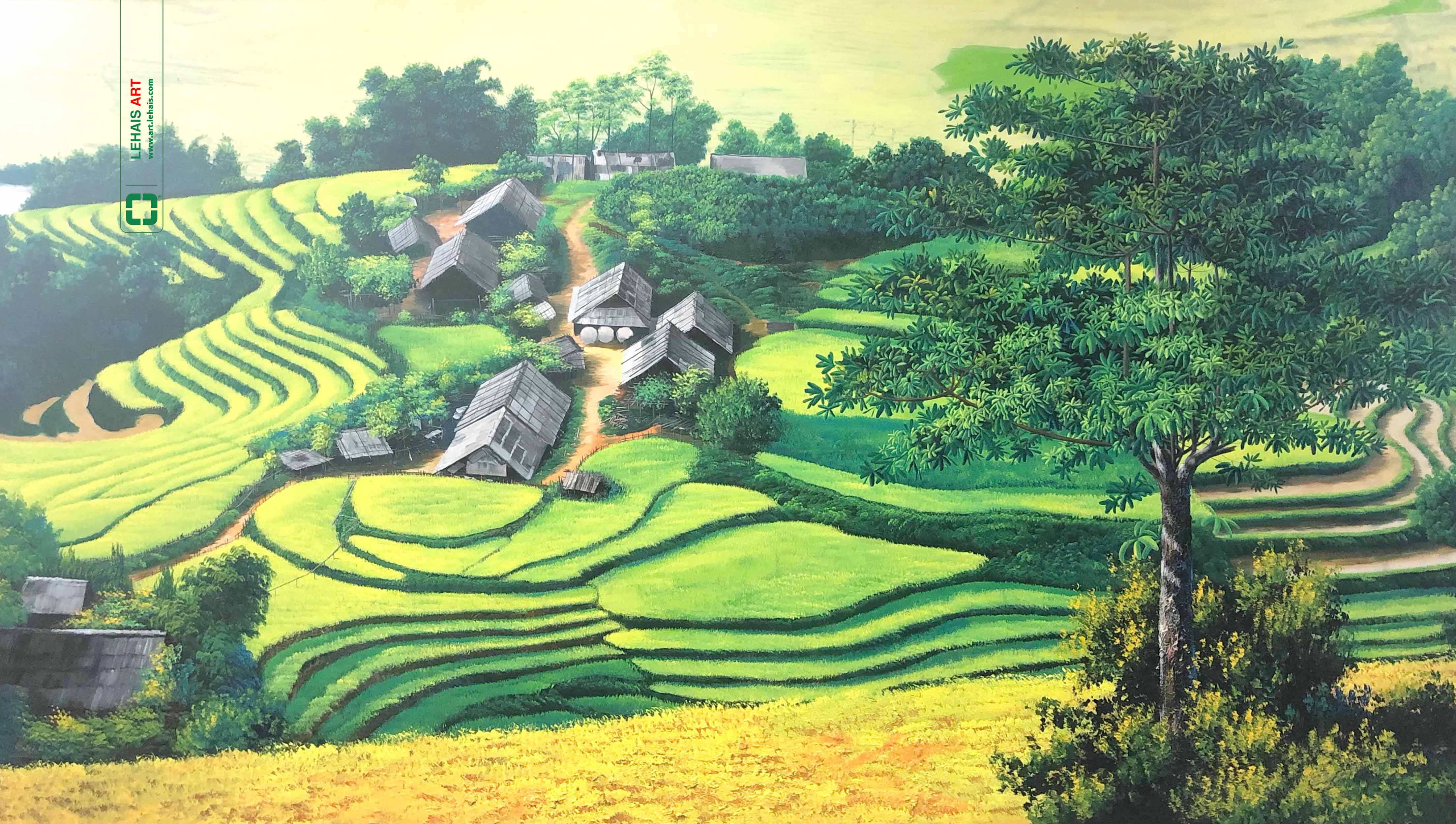
Vietnamese Lacquer as a Base
Some artists use a base layer of traditional Vietnamese lacquer (sơn mài) before applying oil paints. This blend of lacquer and oil paints creates a distinct base, combining the shine of lacquer with the versatility of oil paints in Vietnamese Oil Painting
Eggshells for Texture
Crushed eggshells, a technique used in Vietnamese lacquer painting, are sometimes incorporated into oil paintings to create texture and depth in Vietnamese Oil Painting. The crushed eggshells are mixed with the oil paints and applied to specific areas for a unique effect.
Natural Glues and Resins
Artists in Vietnam may use traditional natural glues and resins derived from natural sources to adhere and mix pigments in Vietnamese Oil Painting. These substances are chosen for their cultural relevance and their compatibility with traditional techniques.
Bamboo Brushes
Bamboo brushes, often handmade, are special tools used by artists in Vietnamese Oil Painting. The use of bamboo brushes is both a cultural nod and a practical choice due to bamboo’s abundance and sustainability.
Gold or Silver Leaf Accents
Gold or silver leaf is sometimes applied as accents in Vietnamese oil paintings. These metallic leaf additions offer a touch of luxury and elegance to specific areas of the artwork.
These special materials add a cultural depth and a distinctive touch to Vietnamese oil paintings, incorporating elements deeply rooted in Vietnamese tradition and identity. Artists often blend these materials with conventional oil painting supplies to create visually captivating and culturally significant artworks.
The way to make a Vietnamese Oil Painting
Creating a Vietnamese oil painting is a labor-intensive and artistic endeavor that demands patience, creativity, and attention to detail. The end result is a visually captivating artwork that may reflect cultural influences and personal expression, making it a meaningful piece of Vietnamese art. Here’s a step-by-step guide on how to make a Vietnamese oil painting
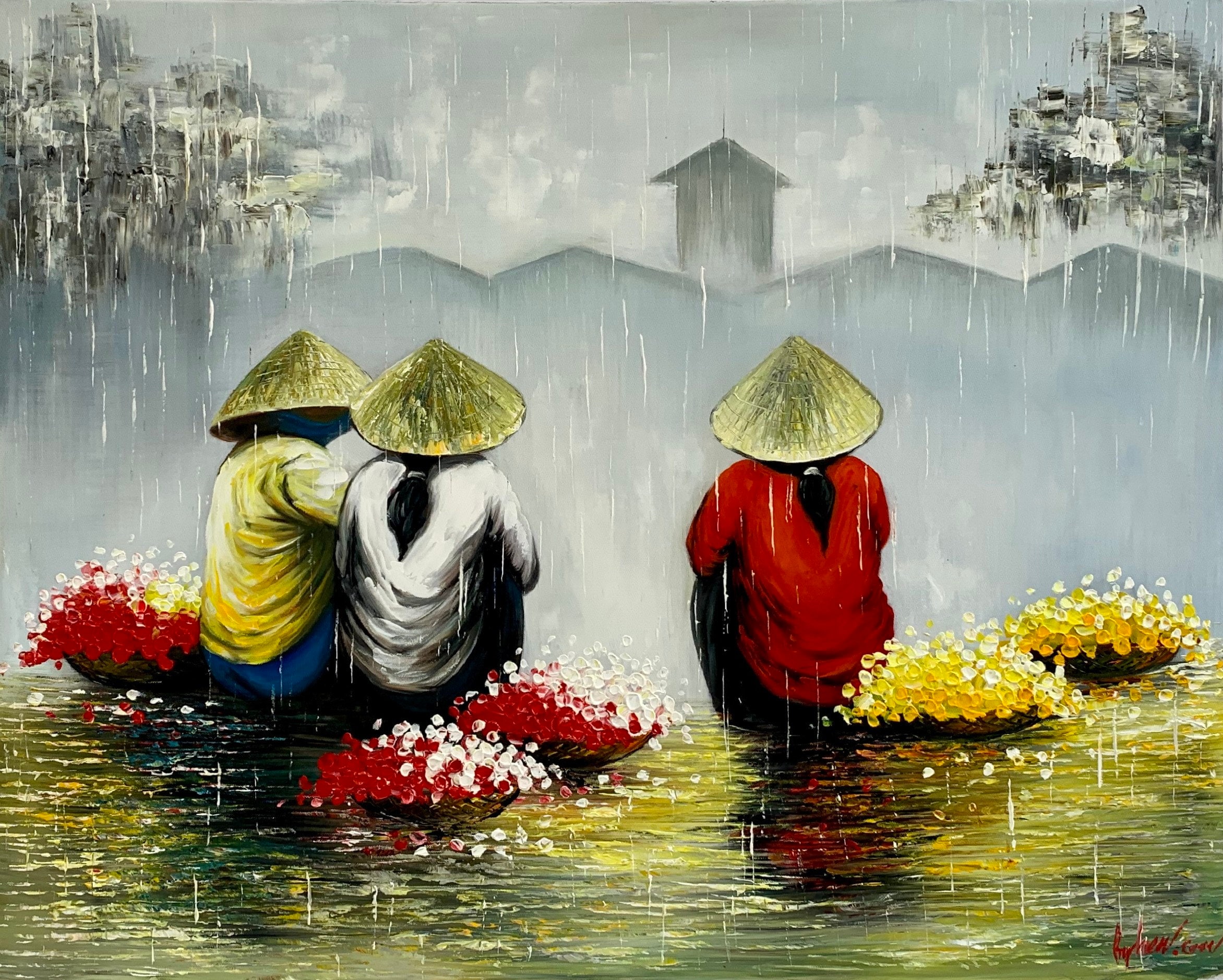
Preparing the Surface
Start with a canvas or wooden panel as your painting surface. If using canvas, it’s common to apply a layer of gesso to prime the surface and create a stable base for the oil paints. Let it dry before proceeding.
Sketching the Composition
Use a pencil or charcoal to sketch the composition directly onto the canvas. This initial sketch provides a roadmap for your painting and helps you position elements accurately.
Mixing Colors
Squeeze out the desired oil paint colors onto your palette. Use the palette to mix and blend colors to achieve the specific hues and shades you need for your painting.
Applying the First Layers
Begin by applying thin, translucent layers of paint to establish the base colors and shapes. This is often called the “underpainting” and serves as a foundation for your artwork.
Building Layers and Details
Gradually build up layers of paint, working from background to foreground. Use different brushes and techniques to add details, texture, and depth to your painting. Oil paints allow for blending and layering, so take your time to achieve the desired effects.
Drying Time
Allow each layer to dry partially or fully before adding the next one. Oil paints can take days or even weeks to dry completely, depending on the thickness of the layers.
Special Techniques (Optional)
If desired, incorporate special techniques like crushed eggshells for texture, metallic leaves for accents, or natural pigments for unique colors. These elements can add depth and cultural significance to your artwork.
Final Touches and Varnish (Optional)
Once you’re satisfied with your painting, make any final adjustments and touch-ups. If you want to protect your painting and enhance its colors, you can apply a clear varnish as a final step.
Drying and Curing
Allow your completed artwork to dry and cure thoroughly. This process can take weeks or even months, depending on the thickness of the paint layers.
Notable Vietnamese Oil painting artists and their contributions
During our art tour, Hanoi Art Tours shares insights about each artist’s background, artistic influences, and the key themes or techniques they are known for. Discuss how their works have contributed to the evolution and recognition of Vietnamese oil painting as a unique and cherished form of artistic expression. Additionally, showcase examples of their work to allow tour participants to appreciate their contributions firsthand.
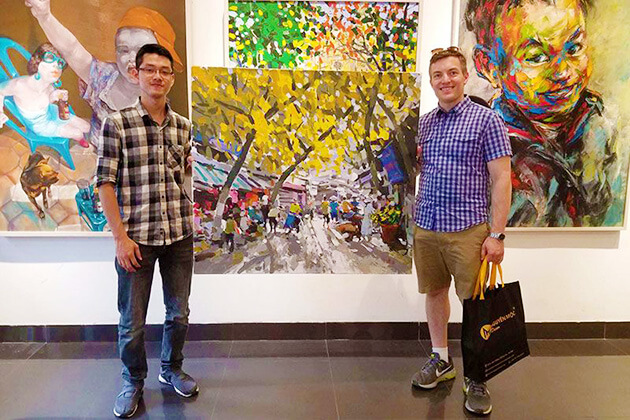
We believe that introducing famous Vietnamese oil painting artists during an art tour can provide participants with a deeper appreciation of Vietnam’s rich artistic heritage. Here are some notable Vietnamese oil painting artists to admire and discuss during your art tour:
Le Pho (1907-2001)
Le Pho is renowned for his Impressionist-style oil paintings that often depict scenes of everyday life in Vietnam, including landscapes, portraits, and still-life compositions. His work has garnered international recognition, and he is considered one of the pioneers of modern Vietnamese art.
Bui Xuan Phai (1920-1988)
Bui Xuan Phai is celebrated for his oil paintings of Hanoi’s Old Quarter. His distinctive style captured the charm and nostalgia of the city’s historic streets and buildings. His works are highly sought after by collectors and art enthusiasts.
Nguyen Gia Tri (1908-1993)
Nguyen Gia Tri, often referred to as the “Father of Modern Vietnamese Lacquer Painting,” made significant contributions to both lacquer and oil painting. His oil paintings often featured landscapes, portraits, and scenes from daily life, demonstrating his versatility as an artist.
Dinh Thi Tham Poong (1948-2010)
Dinh Thi Tham Poong is known for her stunning oil paintings that blend traditional Vietnamese themes with a contemporary touch. Her artworks often feature vibrant colors and intricate details, creating a unique fusion of past and present.
Duong Bich Lien (1914-1988)
Duong Bich Lien was a female artist known for her portraits and oil paintings that showcased the beauty of Vietnamese women. Her works exude elegance and grace, reflecting the cultural ideals of femininity in Vietnam.
Le Thiet Cuong (b. 1942)
Le Thiet Cuong is a contemporary artist known for his abstract and expressionist oil paintings. His works often explore themes of emotion and human nature, offering a contrast to the more traditional styles of his predecessors.
Ho Huu Thu (1915-2008)
Ho Huu Thu’s oil paintings are characterized by their dreamlike quality and use of vibrant colors. He often depicted scenes from rural Vietnam and is celebrated for his contribution to contemporary Vietnamese art.

